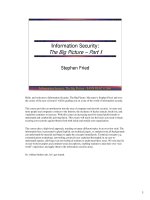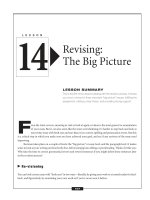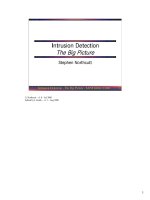Powerpoint GM foods the big picture and introduction to science behind GM foods
Bạn đang xem bản rút gọn của tài liệu. Xem và tải ngay bản đầy đủ của tài liệu tại đây (882.63 KB, 38 trang )
Genetically Modified Foods
The essential questions?
What ethical issues arise from genomic manipulation?
What are the societal implications?
How do scientist manipulate DNA and the genome of an organism?
Project ARISE: Advancing Rhode Island Science Education
Funding provided by a Science Education Partnership Award from the National
Center for Research Resources
Genetically Modified Foods
Student will know:
Students who complete this unit should have a better understanding of the
technology used to develop GM foods and any potential risks and benefits
of genetically modifying organisms.
Project ARISE: Advancing Rhode Island Science Education
Funding provided by a Science Education Partnership Award from the National
Center for Research Resources
Genetically Modified Foods
Students should ask:
Do we have enough information on GM foods to make an informed decision to
support or reject GM foods?
Project ARISE: Advancing Rhode Island Science Education
Funding provided by a Science Education Partnership Award from the National
Center for Research Resources
Genetically Modified Food
ARISE August 3, 2009
Outline
• How to make a GM organism
• Techniques
• Homework for tonight
Have you ever eaten
genetically modified food?
• Can you tell the difference between a genetically
modified organism and a non-GM organism?
• Do GM foods taste any different? Could they?
/>
What is genetic modification?
• Does genetic modification only happen in
plants?
– No, the first gene was transferred into bacteria.
• What are some reasons for genetic
modification?
– Express recombinant insulin in bacteria
• What are some of the benefits and some of
the disadvantages of GM foods?
/> />
How long have humans been
genetically modifying organisms?
• What about in the lab? How long have scientists
been modifying organisms?
• How is modern technology used to genetically
modify organisms?
Teosinte
Why would we want to modify
an organism?
• Better crop yield, especially under harsh
conditions
• Herbicide or disease resistance
• Nutrition or pharmaceuticals, vaccine delivery
• “In 2004, approximately 85% of soy and 45% of
corn grown in the U.S. were grown from Roundup
Ready® seed.”
/>
Roundup Ready Gene
• “The glyphosate resistance gene protects food plants
against the broad-spectrum herbicide Roundup®,
which efficiently kills invasive weeds in the field.
The major advantages of the "Roundup Ready®”
system include better weed control, reduction of crop
injury, higher yield, and lower environmental impact
than traditional weed control systems. Notably, fields
treated with Roundup® require less tilling; this
preserves soil fertility by lessening soil run-off and
oxidation.”
How to make a GM organism
• Clone gene into vector (i.e. plasmid) with
restriction enzymes and other molecular
techniques
• Transform into organism or into biological vector
(agrobacteria or virus)
• Infect plant with bacteria
• Select for transformants with herbicide
/>
What we are doing today
• Extract DNA from plant or food product
• Use the technique of PCR to copy a region of
DNA found in Round-Up Ready foods
• Tomorrow we will analyze these products with
gel elecrophoresis
Many of the same techniques
are used to make a genetic
modifications as to detect one
•
•
•
•
Polymerase Chain Reaction (PCR)
Restriction enzymes
Gel electrophoresis
Transformation
PCR
• Invented in 1983 by Kary Mullis (Nobel Prize in
1993 for its discovery)
• Uses primers to exponentially amplify a specific
region of DNA
• Components needed for the reaction:
–
–
–
–
–
DNA
Primers to region of interest
DNA polymerase (Taq – used to synthesize the DNA)
dNTPS (the building blocks of the copied DNA)
Buffer (with appropriate salts to ensure the enzyme
works properly)
PCR
• Three steps of the reaction:
– Denaturation: High heat (94-98o) to separate the
strands of DNA
– Annealing: (50-60o – depends on the primers) this
step allows the primers to bind to the denatured DNA
strands
– Elongation (74o) – DNA polymerase synthesizes the
new strand
• This step is dependant on the length of the product to be
amplified (1min/1kb of DNA)
• Check products with gel electrophoresis and
sequencing
PCR: Cycles
PCR:
PCR: Thermocycler
PCR: Applications
• Used to test for gene products for disease
diagnosis
• Used to amplify small amounts of material
– Forensics
– Fossil Records
• Used for recombinant DNA technology
• Used for virus detection
Resources
• Potential Problems
– No amplification due to wrong buffer conditions
– No amplification due to lost enzyme activity
– Primers are wrong
• Online Resources:
/>• />• Click on Techniques
– PCR is found in amplifying
Restriction Enzymes
Restriction Enzymes
• Restriction enzymes are also called restriction
endonucleases
– They cut double stranded DNA at sequence specific
sites
– They can produce “sticky ends” or “blunt ends”
depending on the enzyme
Sticky Ends
Blunt Ends
Sticky Ends
Blunt Ends
Restriction Enzymes
• 1978 Nobel Prize in Medicine was awarded to
Daniel Nathans and Hamilton Smith for the
discovery of restriction endonucleases
– Restriction enzymes were discovered in E.coli as a
defense mechanism against bacterial viruses
(bacteriophages)
• The recognition sites are usually 4-12
nucleotides long
– Sequences are palindromic (GAATTC)
• There are hundreds of restriction enzymes
currently being used
Restriction Enzymes
What is better for making recombinant DNA: Sticky ends or blunt ends?
Restriction Enzymes
• Student activity
• Potential Problems:
– Wrong buffer
– * activity
• Online resources http://
www.dnai.org/b/index.html
• Click on Techniques
– Restriction enzymes are found in cutting and
pasting









